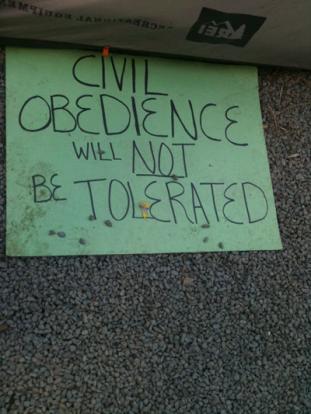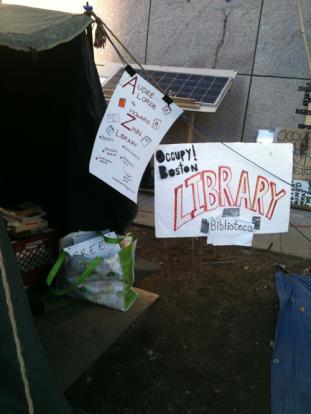
On the last Saturday in October with brilliant blue skies overhead my son, husband and I went down to the Occupy Boston site at Dewey Square to meet a friend of a friend who is serving there with a group of Occupy chaplains. We wanted to get a better sense of the structure, goals, needs and “feel” of the movement here in our fair city. We had been in Baltimore a couple weeks earlier and had stopped briefly at the Occupy Baltimore site so for my nine year old this was both old hat and a wonderfully new experience—this time we were getting a “tour” and were there to learn how we might be of some assistance. There have been a few moments in my life that prove, forcefully, the critical links that exist between my vocation as a humanities scholar and my avocation as an agent of social change: this was one of them. I found myself immersed in a place and time that recalled for me other places and times not only in my life but in the life of the United States. Places and times when the whole was greater than the sum of its parts and out of many concerns came something unexpected and transformative.
Greeting us as we stepped onto one of the wooden sidewalks that run through the tents was a sign with a quotation from Theodore Roosevelt, while over my shoulder was a 9 foot tall sculpture of Gandhi and down the “street” was a library tent announcing its holdings as extending “From Audre Lourde to Howard Zinn”. Off to my right was the faith and spirituality tent, its interior full of (among other things) prayer flags and bibles, an altar and space for yoga and meditation. To the left was a carefully roped off community garden; the occupiers are working hard to protect the landscape on which they are encamped. Just ahead was a food tent with servers behind the tables, and as we wound our way through tents we met members of the security team, heard announcements about an upcoming public reading, and nodded hello to other parents with children, young adults and members of the baby boom generation. We overheard conversations referencing Dorothy Day and Karl Marx and Oakland and Columbus. We learned about the structure of decision making at general assemblies held once or twice a day, the work underway to plan for weatherization, and the efforts of the media and technology team who have built and are maintaining the website among other things.
quotation from Theodore Roosevelt, while over my shoulder was a 9 foot tall sculpture of Gandhi and down the “street” was a library tent announcing its holdings as extending “From Audre Lourde to Howard Zinn”. Off to my right was the faith and spirituality tent, its interior full of (among other things) prayer flags and bibles, an altar and space for yoga and meditation. To the left was a carefully roped off community garden; the occupiers are working hard to protect the landscape on which they are encamped. Just ahead was a food tent with servers behind the tables, and as we wound our way through tents we met members of the security team, heard announcements about an upcoming public reading, and nodded hello to other parents with children, young adults and members of the baby boom generation. We overheard conversations referencing Dorothy Day and Karl Marx and Oakland and Columbus. We learned about the structure of decision making at general assemblies held once or twice a day, the work underway to plan for weatherization, and the efforts of the media and technology team who have built and are maintaining the website among other things.
I paint this picture for you not because you have not seen images of Occupy sites across the nation–you probably have–but because as we walked and talked and asked questions, the everydayness of lunch, reading, discussions and cleaning up was the overwhelming theme. I saw my son’s original trepidation turn to genuine interest. Where did people sleep? Why did they pick this site? What was “that” sign all about? Who cooked the food? Were there any kids sleeping here? And, again and again, “Mommy, what do they want to have changed?”
I was unable to answer this. A flippant “everything” was not right, but a litany of specific items did not seem quite right either. As I stood there I thought the following
- I know the statistics on wealth disparity in the US
- I know the number of people who are without insurance or under insured
- I know only too well (as a college professor) the crushing loan debt that young people face
- I know about mortgages that are underwater and the devastating effects on individuals and our national/global economy of the sub-prime and banking issues of these past few years
- I know that I am among the lucky to have a solid well-paying job
- …and the list went on and on in my head…
And…as I looked at the posters and banners all around me it was clear that the list in my head was not so far off from the list on the minds of the occupiers whose signs might function as tweets for the Public Humanist:
“Those who would sacrifice a few fundamental liberties in the name of security deserve neither.” – Benjamin Franklin (albeit in a slightly altered form)
“Civil obedience will not be tolerated” (here, channeling Thoreau)
“I prefer peace. But if trouble must come, let it come in my time, so that my children can live peace.” – Thomas Payne
“The world holds enough for everyone’s need but not for everyone’s greed”
“People have the power”
“Never Give Up, Never Give Up, Never Give Up”
The question my son asked was on others’ minds as well. “But what,” one of my fellow visitors asked of our host, “do the occupiers want?” “What is the end game?” ”What would success look like?” The answer came back something like this (and I paraphrase here): There is no easy answer. There are many issues. There is a sense that for now the ambiguity is OK. The broad set of concerns and voices here are needed, are necessary. They speak to the many concerns. There is much to be changed.
As a scholar who has studies both the Gilded Age/Progressive era, religion and political activism, and the social change movements of the 1960s/70s I stood there in the middle of an “aha” moment.
So this is what it might have felt like in 1890? So this is what it might have felt like in 1910? So this is what it might have felt like in 1968? So this is what it might have felt like in 1973? It is only too easy to look back from afar and in the context of historic periodization to talk about THE Progressive era or THE 1960s. Digging deeper into those “moments” as many scholars and educators have done, reveals that then, like now, there were many, many issues (often competing) that, up close, must have looked and sounded as “leaderless” and “unorganized” as some have claimed the Occupy movement to be.
In the Progressive Era, the “groups” who collectively raised their voices over concerns as wide ranging as child labor laws and women’s suffrage and anti-lynching laws and farmers’ rights and anti-monopoly legislation at the turn of the 20th century constituted no more or less of a unified “movement” than what I saw in Dewey Square. The anti-war, and women’s rights, and Black Power and gay rights “groups” who loom large in our collective memory of “the 60s” were no more or less a “movement” than what I saw at Dewey Square. Yes, some concerns are unique to our time, but as a whole what these eras and democratic actions share is a common belief in something resembling structural change. The goal is bigger than any of the specific requests. Structural changes in laws, norms, expectations and social codes are what resulted from the sustained and often amorphous threads of other transformative moments in our history.
Whether motivated by unemployment, theories of social justice, theological/moral teachings, or economic/political stances, it struck me on Saturday that what I was seeing and feeling at the Occupy Boston site was a bit of what my historical subjects might have tasted or felt in other places and at other times that I’ve written about before on this blog including the takeover of 888 Memorial Drive in Cambridge in 1971, the wealth discrepancy that motivated the publication of “Looking Backwards” in 1888, Walter Rauschenbusch and the Beechers , and the creative appropriation of cultural tourism to address the needs of recently-arrived Americans at the House of the Seven Gables in 1910.
Now I write as an historical actor. I was there. I can’t forget. I am thinking, I am wondering. How will we write this history? How will the currently “leaderless” and “unfocused” movement be remembered?
I close here with a link to a statement that the Council of my own professional organization The American Studies Association wrote, read and published at our annual meeting this fall. It helps me make the case that as humanists we are, most of us (like it or not!) part of the 99%. Our work engages us in the complex discourses on display at Occupy Boston. Check it out…
“We are the public. We are workers. We are the 99%. We speak with the people here in Baltimore and around the globe occupying plazas, parks, and squares in opposition to failed austerity programs, to oligarchy, and to the unequal distribution of wealth and power. The loss of jobs, healthcare, and homes, the distressing use of mass incarceration and mass deportations, and the destruction of environments have brought so many households and individuals to crisis. We join with people re-claiming commons rights to public resources. We join in the call against privatization and for a democratic re-awakening.
As educators, we experience the dismantling of public education, rising tuition, unsustainable student debt, and the assault on every dimension of education. As American Studies scholars, our work includes, among other things, addressing the problems and challenges societies face, drawing lessons from the past, comparing across polities, and making informed recommendations that will spark open debate. We draw inspiration from earlier social movements that have challenged the unequal distribution of power, wealth, and authority. Today’s movements continue this necessary work. The uprisings compel us to lift our voices and dedicate our effort to realizing the democratic aspirations for an equitable and habitable world. We are the 99%”
Photos Courtesy of Elizabeth Duclos-Orsello


